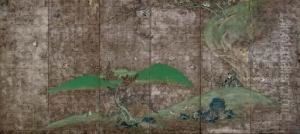Unkoku Toson Paintings
Unkoku Tōgan (宇宮 洞雁) was a Japanese painter of the Momoyama and early Edo periods. Born in 1587, he was originally named Mimura Tōgan before being adopted into the Unkoku family, a lineage of painters who were the artistic heirs to the prominent 16th-century master Sesshū Tōyō. Sesshū's influence was foundational for Japanese ink painting, and his school continued to be a major force in the art world of Japan after his death.
Unkoku Tōgan became the second head of the Unkoku school, which had been founded by Unkoku Togan's adoptive father, Unkoku Sūgan. He worked to carry on the style of Sesshū, focusing on ink landscapes that reflected the aesthetics of the Muromachi period. Tōgan's paintings are characterized by their bold and dynamic brushwork, which was somewhat more forceful than that of Sesshū himself.
Tōgan's works contributed to the perpetuation of the Sesshū style through the early Edo period, bridging the transition between the war-torn era of provincial conflict and the more peaceful and culturally rich Edo period. His paintings often embodied a sense of tranquility and depth, with monochrome ink used to create varying shades and textures. This style of painting was known as 'haboku' (splashed ink) and 'tarashikomi' (dripping in), which were techniques used to create atmospheric and natural landscapes.
Although the Unkoku school was overshadowed by the emergence of new schools and styles of painting such as the Kanō and Rinpa schools, the Unkoku lineage, through Tōgan and his successors, maintained the integrity of Sesshū's artistic vision. Unkoku Tōgan died in 1636, leaving behind a legacy that would influence Japanese painting for generations. His works are preserved in several important collections, including those of temples and museums in Japan, and they continue to be studied and appreciated for their historical significance and artistic merit.
